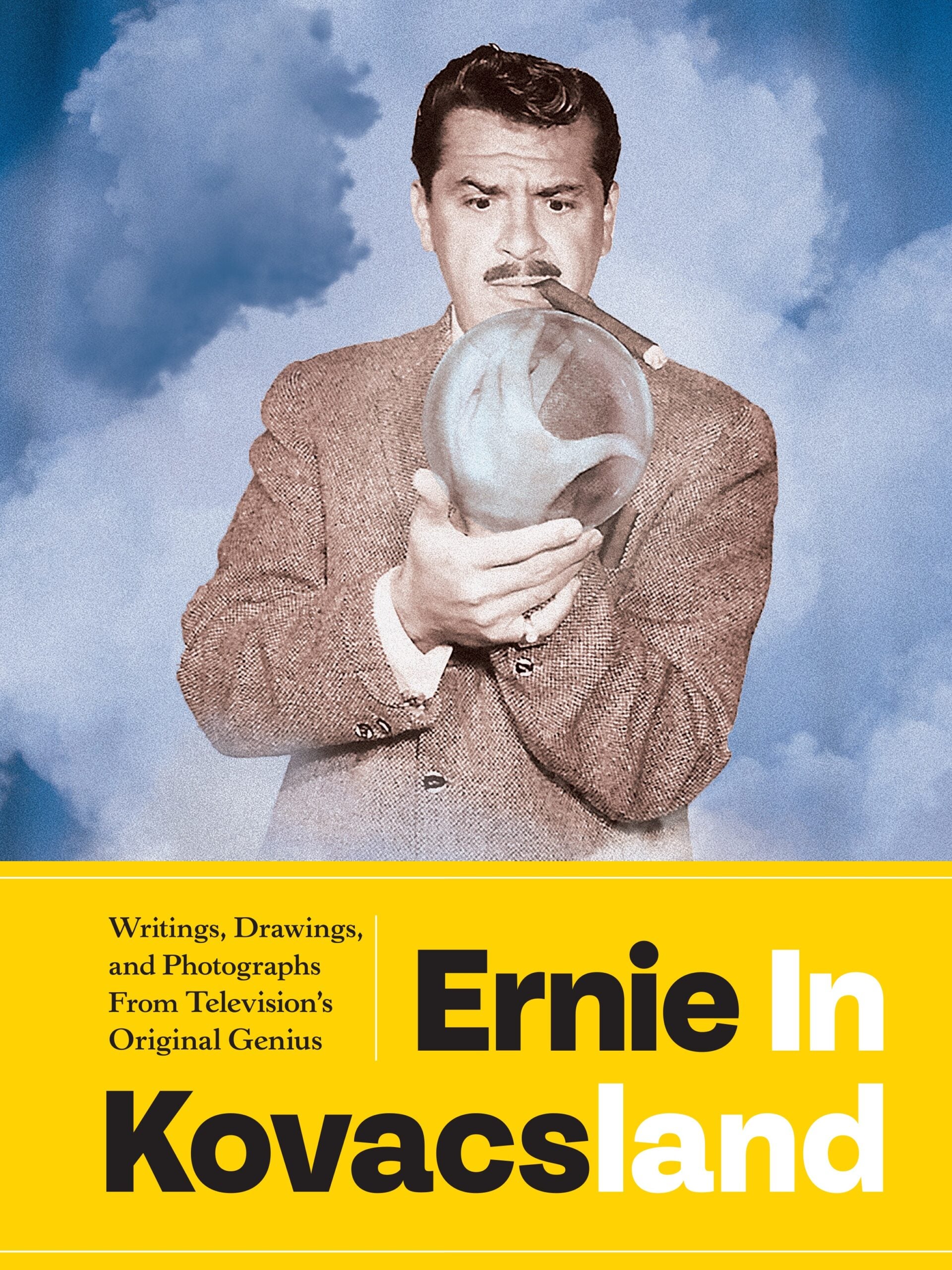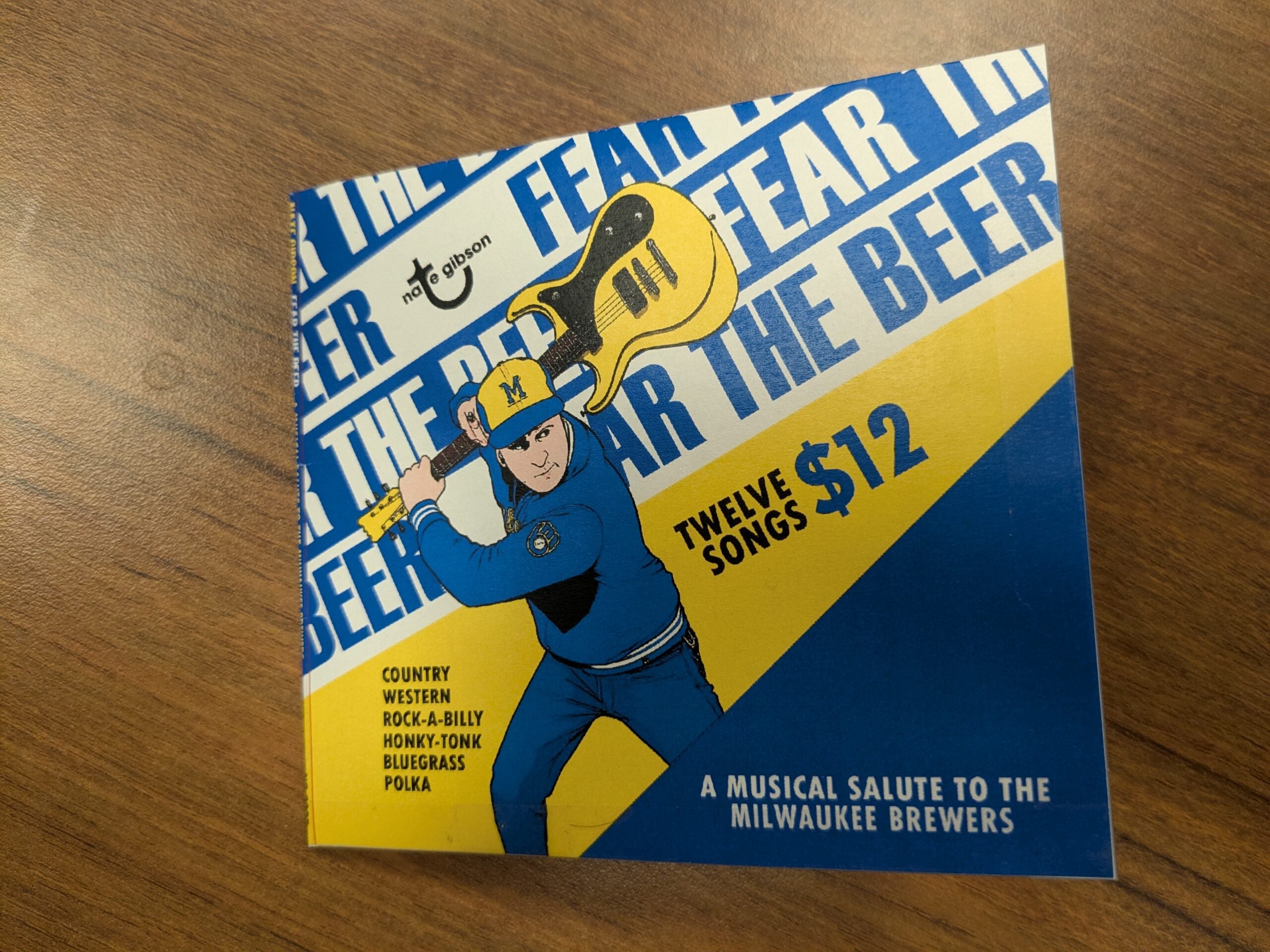Mike Mills of R.E.M. takes us out to the ball game with his concept supergroup, The Baseball Project. Also, Josh Mills shares the story of one of the most innovative television comedians ever – the one and only Ernie Kovacs. And Alex Pappademas takes us inside the brilliant minds of Steely Dan.
Featured in this Show
-
R.E.M.'s Mike Mills takes us out to the ball game with The Baseball Project
At the 50th birthday party for R.E.M. bassist Mike Mills, guitarist Steve Wynn and multi-instrumentalist Scott McCaughey were chatting with each other about their mutual love of baseball and rock and roll.
That conversation became the germ of an idea to form a supergroup that included Steve’s wife, Linda Pitmon on drums and Mills’ fellow R.E.M. co-founder Peter Buck on guitar. It was to combine their collective loves of baseball and rock and roll. They called it The Baseball Project.
Mills tells Wisconsin Public Radio’s “BETA” that the concept feels like a natural fit for a tribute band.
“Baseball is about storytelling. You know, baseball is about nicknames and managers and weird behaviors and leisurely games and all of that sort of thing,” he said. “I think baseball is the perfect milieu for this.”

Photo courtesy of Kurt BlochEven though Mills’ birthday party sparked the idea for the group, he wouldn’t officially join them until Buck was unable to make a concert in Spain.
“Peter couldn’t go. So, they asked me to sub in on bass and I said, ‘Well, sure, I’d be glad to.’ And so then I became a member of the band. So now it’s: I’m the bass player and Peter is a guitar player,” Mills recalled.
The Baseball Project has released its fourth album, “Grand Salami Time.” It’s full of tracks that are both reverent and irreverent about America’s pastime. The album was produced by early and longtime R.E.M. producer Mitch Easter.
“It’s always a pleasure to work with Mitch. He’s one of my favorite people in the world. Even aside from his incredible talent in the studio and on guitar, I’ve kept up with Mitch over the years,” Mills said.
Mills said that Easter’s influence on the album came down to his ability to understand the sound the band wanted and make moves to get it there. He also added that Mitch offered his trademarked “technical proclivities,” which date back to R.E.M.’s earliest single, “Radio Free Europe.”
“He would put an AM station on static. On no station at all, just AM radio. And then he would gate that noise, that sort of white noise, into the snare sound,” says Mills. “It added just a little, you know, je ne sais quoi to the overall sound. And it’s just a really cool effect.”
That mind-meld on sound design shows up on the foreboding and dystopian riff that propels the song, “Stuff” — Mills’ lone songwriting contribution to “Grand Salami Time.” Despite its sound, the track is a playful take on baseball’s longtime problem with pitchers using all kinds of illegal substances on baseballs during games.
“It turns out part of putting stuff on the ball is to make it do crazy things. The other part of it is to have control over it. And so hitters don’t mind because, you know, when somebody is throwing the ball 98 miles an hour right next to your body, you want them to have control over it. And the other aspect of it is that everybody’s doing it,” Mills said.
“I just decided to make it kind of creepy and menacing. And then when I sang it, I wanted to keep that element in the song. You know, the vocal needs to match the music,” Mills continues. “I’m not particularly menacing person, but I tried to give it some sort of menace in the vocal.”
Other tracks on the album cover other baseball phenomena like the yips, or the various home run calls announcers create that inspired the title track.
“One of the joys of baseball is the idiosyncrasies of each team’s announcers. And announcers have to decide how they’re going to call home runs. And each year most announcers have their own particular way of doing it. Some of them are more colorful than others. So, we really enjoyed knowing how the different announcers approach their homerun calls,” Mills said.
One said announcer even gets his own track. The song “The Voice of Baseball” is a tribute to the late, great Los Angeles Dodgers radio play-by-play man, Vin Scully.
“Vin is an all-timer. He was one of the last to be a neutral announcer, as they were all originally trained to be. Now, every team’s announcers are homers,” Mills said. “That’s the sort of professionalism we have to respect, because sometimes the cheerleading for your own home team can get kind of tiresome.”
“Plus, Steve does a really good imitation of him, and that’s a lot of fun too,” he adds.
In addition to going on the road in support of “Grand Salami Time” (where tour date venues are set in baseball stadiums as often as possible), Mills has been adapting a series of R.E.M. songs into a concerto.
“I took 10 R.E.M. songs and I split them between two arrangers, and I said, ‘OK, I want you to arrange these songs for a symphony or a string orchestra first,’” Mills said. “They’re still R.E.M. songs, but I want you to take them wherever places you want them to go.”
He also noted that a solo album isn’t out of the picture, it also isn’t on the horizon.
“I keep thinking about it and I’ve got a bunch of stuff kicking around, but I have all these other wonderful projects that I do, and I’m really enjoying them. I’m sure that the solo album will happen. I just don’t know when,” Mills said.
We’re sure when it arrives, it’ll be a home run.
-
How Ernie Kovacs revolutionized TV comedy
If you’re looking for the seismic shift that revolutionized television comedy, you have to go back to the 1950s and the visual and immersive innovations of Ernie Kovacs.
“Unlike many comedians of that era, he was not a stand-up. He wasn’t a performer in that sense, but he was a very visual comedian,” editor Josh Mills told Wisconsin Public Radio’s “BETA.”
Mills is the editor, along with Ben Model and Pat Thomas, of the book, “Ernie in Kovacsland: Writings, Drawings, and Photographs from Television’s Original Genius.“

Book cover courtesy of Fantagraphics Kovacs started in newspapers and then went into radio and television, Mills explained. But he’s best known for his visual humor — a little like the silent era but truly Kovacs’ own.
“It can be very arty. I can be very weird,” Mills said.
But what kept nagging at Mills is how Kovacs knew his brand of comedy would work in the 1950s.
“There was no precedent for this in television,” he said. “Everybody was looking at it as essentially theater. There are no four walls. There’s just three walls. And Ernie broke all the rules very early on. He would let you know that, ‘Hey, I’m on television, you’re watching me. I’m doing this for you.’”
Mills has a personal connection to Kovacs. Edie Adams was Mills’ mother, and she was married to Kovacs. Adams frequently appeared with Kovacs on his TV shows. They both received Emmy nominations for best performances in a comedy series in 1957. Adams won a Tony Award for Best Featured Actress in a Musical for her role as Daisy Mae in “Li’l Abner,” which was based on Al Capp’s comic strip.
Adams and Kovacs were married for seven years when Kovacs tragically died in a car accident on Jan. 13, 1962. He lost control of his station wagon while making a quick turn and crashed into a power pole in Los Angeles. Kovacs was only 42.
Adams realized how valuable Kovacs’ work was, so she worked hard to save everything.
“She saw firsthand how special he was,” Mills said.
Mills explained that after Kovacs died, Adams was hearing the networks were getting rid of Kovacs’ work, either by throwing away his things in the Hudson River or by wiping the tapes and using them for weather reports or blank tapes.
“And my mom in the mid-’60s essentially decided this can’t happen,” Mills said. “She got a quick claim, got a lawyer and she went to all the networks and said, ‘If it says Kovacs on the box, I will buy it.’”
“So for that, she is the patron saint of television preservation, one of the early adopters when there was really no understanding of this,” he added.
Mills said he can’t think of anyone who was more relaxed on TV than Kovacs, and he was talented at ad-libbing.
“Ernie takes his time and there are moments where things don’t work and there are things that go wrong and he doesn’t care,” Mills said. “And in fact, it’s better when those things happen… He always said, the best ideas I ever had (were) 15 minutes before air. So I think he was really into the idea of ad-libbing.”
One of Ernie’s most famous recurring segments was the Nairobi Trio, which featured many different people including Adams, Jolene Brand, Jack Lemmon and Tony Curtis.
“You never knew because they were all wearing masks. They would do it live and Sinatra would pull off his mask. It was crazy. But it’s one of those things that…you’re waiting, and you’re waiting, and you’re waiting and what’s going to happen?” Mills said.
“And I think that that was the genius of Ernie. He kind of pulled in everybody from the margins and also, in a weird way, changed their perception of comedy,” he continued.
If Ernie Kovacs was still with us today, what does Mills think that our TV shows and streaming services would look like?
“I think they’d look the same because he’d be doing it on YouTube. I think he’d be doing it on the Internet,” he said. “I think unless someone offered him a boatload of money, I don’t think he’d be doing television.”
Mills said that Model, one of the co-editors of the book and the official archivist of Kovacs and Adams, believes that Kovacs would have been a film director — he was moving in that direction.
-
Steely Dan’s Walter Becker and Donald Fagen: 2 of modern music’s greatest inside jokers
While making Steely Dan’s seventh studio album — which came out in November of 1980 — Walter Becker, the band’s co-founder, was crossing a New York City street when he was hit by a taxicab. It took six months for him to heal.
He explained that he and the taxi were Quantum Criminals, two particles trying to occupy the same space simultaneously. And so, the title of Alex Pappademas‘s book about Steely Dan was born — “Quantum Criminals: Ramblers, Wild Gamblers, and Other Sole Survivors from the songs of Steely Dan.”
Wisconsin Public Radio’s “BETA” talked with Pappademas about the music of Steely Dan and the worlds their songs created.
“In most of Steely Dan’s songs,” Pappademas said, “you get the sense that you are looking through the keyhole at a fully-realized world. It feels like you are looking in on a story that was in progress before you got there and will probably continue after the glimpse you get in the song. They always said they wanted it to feel like you were passing someone on the street and hearing a bit of their conversation.”
Becker and Donald Fagen met at Bard College in upstate New York. They found similar interests, including Vladimir Nabokov, Kurt Vonnegut, Robert Altman and musicians like Tom Lehar and Frank Zappa.
“They were an incredible sensibility match. They met their creative soulmate very early. Everything they did together as Steely Dan felt like it was, first and foremost, them trying to amuse one another and play to the things they all liked,” Pappademas said.
The song “Do It Again” from Steely Dan’s first record becomes a template that Pappademas says the band rewrote repeatedly.
“It’s the first song on their first record and their first hit. It’s one of the songs that people associate with them. It became a sort of signature song,” Pappademas said. “It’s about a loser or a series of losers, depending on how you view it. It’s about someone who keeps making mistakes and somehow lives to make more mistakes.”
“That’s the very beginning of their 70s run. And you get to the end of the 70s with Gaucho. You have a song like ‘Babylon Sisters,’ narrated by a man going into some sexual rendezvous situation that everyone has warned him about. Yet, he’s going to do it anyway,” Pappademas continued. “There is something in many of these Becker-Fagen songs about people racing toward their doom. They know exactly what’s happening, but it’s the urge to self-destruction that so many of these characters pursue.”
In the book, those characters come alive because of the brilliant art by Joan LeMay, especially her illustrations of the characters from the songs.
“I’d started writing an outline for a Steely Dan book for the University of Texas Press,” recalled Pappademas. “I had many ideas, and I was thinking, OK, this is a bunch of short essays about Steely Dan, but I didn’t know what the spine of it would be. Out of nowhere … Joan launched this idea that she was going to draw all the Steely Dan characters. It was the piece that was missing.”
“This book provides a visual element for a band that never had a strong visible presence,” he added. “For a long time, they were mostly anonymous. There are no music videos. Joan’s images imbue these characters with so much humanity. There’s so much pride and shame, and they’re looking at you with a wariness that makes this book work on a level I don’t think I could have achieved with prose writing and a couple of licensed black and white photos.”
In 1977, Steely Dan released “Aja,” their most famous record. By now, Steely Dan had perfected their sound and found the musicians who could play the music just as Becker and Fagen wanted.
“I think it is the point where their songwriting and relentless pursuit of perfection in performance lined up. It’s a great batch of songs recorded by an incredible group of players. They were working with more New York musicians. They had finally moved back to that world. It was the best-case scenario for this kind of record-making and for what it can produce because it is a technically flawless album that is also, to my ears, incredibly soulful and beautiful, and full of heart and thought,” Pappademas said. “It is a tight, perfect, and unimpeachable suite of songs to me.”
A few years later, in 1980, that goal of perfection worked against them while recording the album, “Gaucho.” Pappaddemas said he thinks it was mainly due to burnout from the fast and loose 70s.
“I think a couple of things are happening on ‘Gaucho.’ One of the things that is going on is that maybe they’ve taken it too far. Another thing about ‘Gaucho’ is that Walter Becker has been struggling with some personal and substance abuse issues for a while and is a little bit missing from the process. Even before he was injured in that cab accident, that gave the book its title. He’s drifted away from the process,” Pappaddemas said.
“If you think of Steely Dan as this creative love affair between these two guys, Donald and Walter, and this thing that they were doing principally to please themselves. Once Walter is out of the picture, I think it becomes less fun to work in the way they were working … You see Donald alone and miserable in the studio. It’s because he does not have the guy he’s accustomed to working with. It’s as burned out and end-of-the-70s record as you could ever hear. And it feels like the toll of those years is coming to bear both on the characters and if you read between the lines on Donald and Walter themselves,” he continued.
Still, Pappaddemas said it’s the album that turned him into a Steely Dan fan.
Becker died in 2017, ultimately changing Steely Dan for good. Pappademas speculated how Steely Dan will be remembered in the years to come.
“I hope that they’re seen as one of the most important and fruitful creative partnerships of their era, that they’re seen on the level of Rodgers and Hammerstein, Lennon-McCartney, Bacharach and David,” he said. “I hope that Becker and Fagan are seen on that level, and I hope that this songbook continues to be something people return to often.”
Episode Credits
- Doug Gordon Host
- Adam Friedrich Producer
- Steve Gotcher Producer
- Steve Gotcher Technical Director
- Steve Gotcher Interviewer
- Mike Mills Guest
- Josh Mills Guest
- Alex Pappademas Guest
Wisconsin Public Radio, © Copyright 2026, Board of Regents of the University of Wisconsin System and Wisconsin Educational Communications Board.





